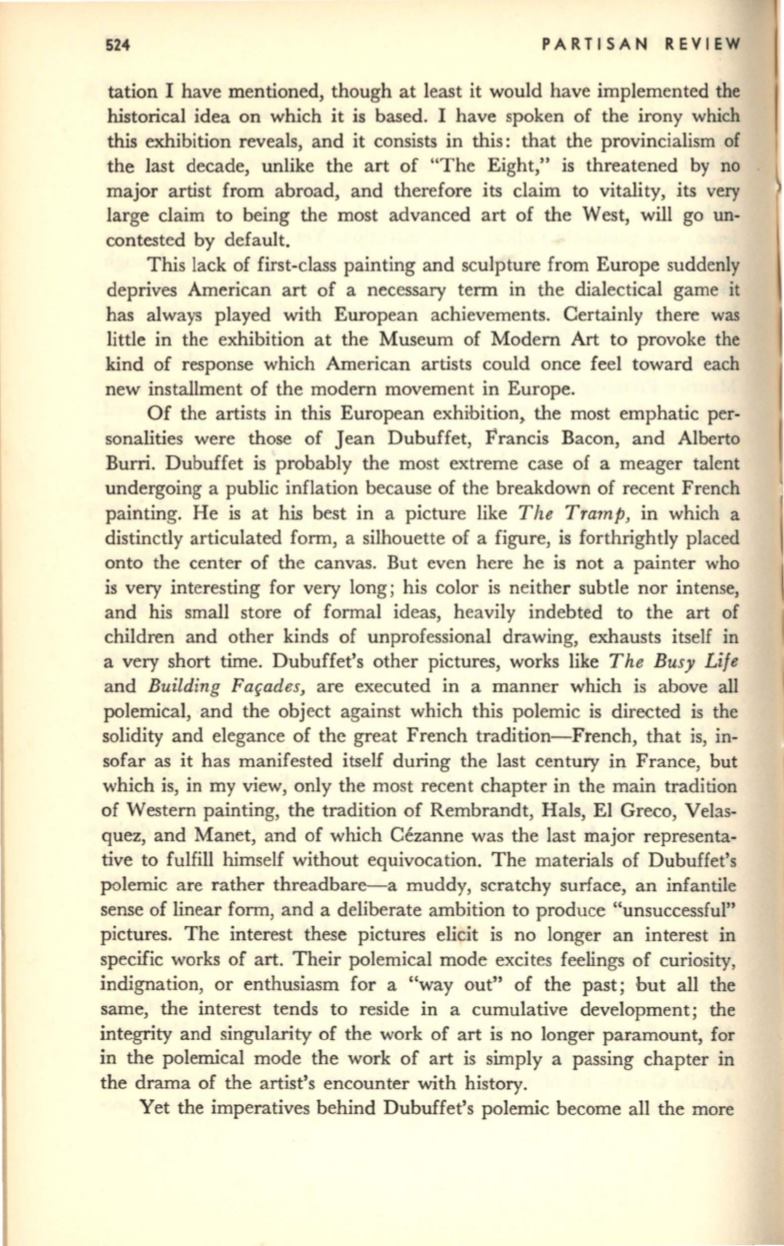
524
PARTISAN REVIEW
tation I have mentioned, though at least it would have implemented the
historical idea on which it is based. I have spoken of the irony which
this exhibition reveals, and it consists in this: that the provincialism of
the last decade, unlike the art of "The Eight," is threatened by no
major artist from abroad, and therefore its claim to vitality, its very
large claim to being the most advanced art of the West, will go un–
contested by default.
This lack of first-class painting and sculpture from Europe suddenly
deprives American art of a necessary term in the dialectical game it
has always played with European achievements. Certainly there was
little in the exhibition at the Museum of Modern Art to provoke the
kind of response which American artists could once feel toward each
new installment of the modern movement in Europe.
Of the artists in this European exhibition, the most emphatic per–
sonalities were those of Jean Dubuffet, Francis Bacon, and Alberto
Burri. Dubuffet is probably the most extreme case of a meager talent
undergoing a public inflation because of the breakdown of recent French
painting. He is at his best in a picture like
The Tramp,
in which a
distinctly articulated form, a silhouette of a figure, is forthrightly placed
onto the center of the canvas. But even here he is not a painter who
is very interesting for very long; his color is neither subtle nor intense,
and his small store of formal ideas, heavily indebted to the art of
children and other kinds of unprofessional drawing, exhausts itself in
a very short time. Dubuffet's other pictures, works like
The
Busy Life
and
Building
Fafades,
are executed in a manner which is above all
polemical, and the object against which this polemic is directed is the
solidity and elegance of the great French tradition-French, that is, in–
sofar as it has manifested itself during the last century in France, but
which is, in my view, only the most recent chapter in the main tradition
of Western painting, the tradition of Rembrandt, Hals, El Greco, Velas–
quez, and Manet, and of which Cezanne was the last major representa–
tive to fulfill himself without equivocation. The materials of Dubuffet's
polemic are rather threadbare-a muddy, scratchy surface, an infantile
sense of linear form, and a deliberate ambition to produce "unsuccessful"
pictures. The interest these pictures elicit is no longer an interest in
specific works of art. Their polemical mode excites feelings of curiosity,
indignation, or enthusiasm for a "way out" of the past; but all the
same, the interest tends to reside in a cumulative development; the
integrity and singularity of the work of art is no longer paramount, for
in the polemical mode the work of art is simply a passing chapter in
the drama of the artist's encounter with history.
Yet the imperatives behind Dubuffet's polemic become all the more


